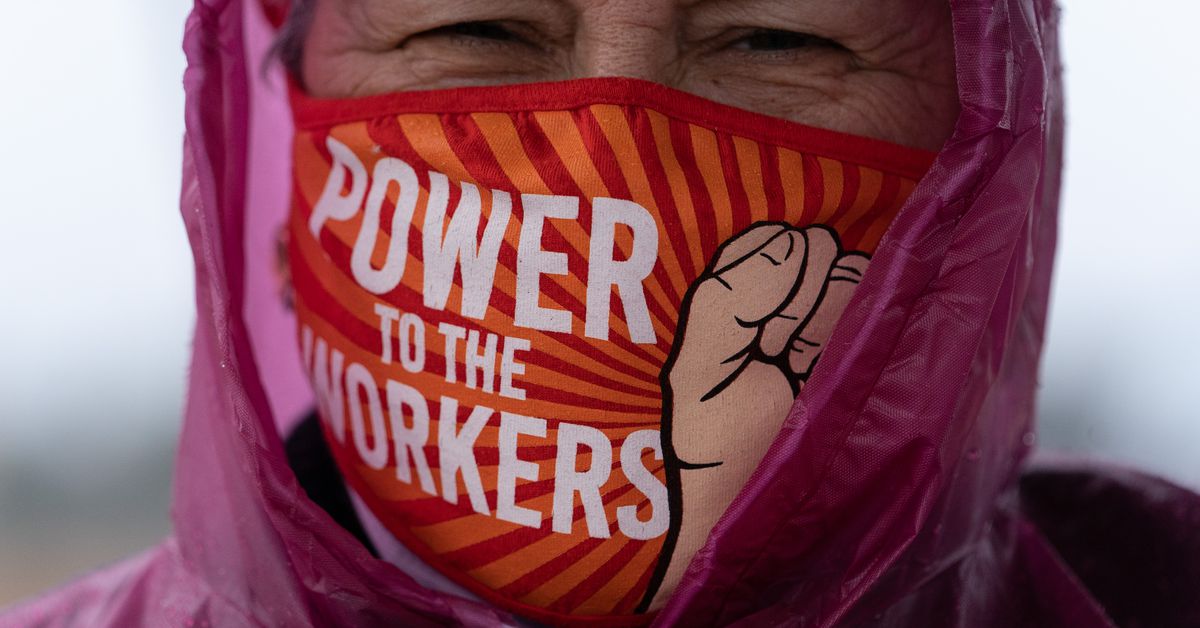
Last week, President Joe Biden had a message for Amazon: I’m watching.
“Workers in Alabama — and all across America — are voting on whether to organize a union in their workplace,” he tweeted, along with an accompanying video. “It’s a vitally important choice — one that should be made without intimidation or threats by employers.”
Biden didn’t name the employer involved, but it was clear to anyone paying attention to one of the biggest union battles in recent US history that he was talking about the e-commerce giant Amazon.
Through the end of March, 5,800 workers at an Amazon warehouse in north-central Alabama have the chance to cast votes by mail to decide whether to unionize. These employees are just a tiny fraction of Amazon’s 500,000-plus front-line US workforce, but this union vote could reshape the company’s labor practices — and maybe the future of warehouse work in America as well.
The union vote at BHM1, a four-story Amazon warehouse the size of 15 football fields located in Bessemer, Alabama, is the first attempt to unionize a large US Amazon facility in the tech giant’s 25-year history. If a majority of the workers who choose to vote opt for unionization, they’ll earn a right to bargain for a contract with Amazon under the Retail, Wholesale and Department Store Union (RWDSU), which represents retail staff at department stores like Macy’s and H&M, as well as thousands of poultry plant workers.
A union victory in Bessemer would mark a historic win for US labor organizers who have long failed to crack Amazon, which is the second-largest private-sector employer in the US and has been accused of demanding a punishing pace of work and surveilling its workforce too aggressively. It would also likely set off a union push at other Amazon facilities across the US. Such a scenario once seemed like a pipe dream, but now seems, at a minimum, plausible. And it’s something Amazon executives have long feared because of how it might upend the speed and agility of warehouse operations; typically, the faster Amazon pushes warehouse workers, the quicker the company can get orders out the door to customers. And the express shipping options that come with an Amazon Prime membership are one of the key reasons shoppers choose the tech giant over competitors.
The Amazon BHM1 employees who support unionizing aren’t necessarily demanding better pay or benefits; the company pays employees a starting wage of at least $15.30 per hour at the facility, and it offers medical benefits for full-time employees and some part-time workers. Rather, the workers in favor of unionizing want a variety of changes that Jennifer Bates, who trains new workers at BHM1 as a full-time “learning ambassador,” sums up this way:
“Being heard.”
Inside Amazon’s corporate headquarters, company leaders are treating the vote as a crisis, according to an Amazon source. The company is pushing hard to convince workers to vote against unionization — convening mandatory in-person meetings during worker shifts to stress the upside of the current work environment and the downsides of unions, sending frequent texts to workers with anti-union messages and encouraging them to vote no, and even posting anti-union flyers on employee bathroom stall doors.
“It’s overkill,” said Bates, who told the union she was willing to speak to the press. “Sort of like a stalker.”
In a statement, Amazon spokesperson Heather Knox highlighted the company’s benefits to employees and said Amazon does not believe that RWDSU’s views represent those of the majority of employees at the warehouse.
“We work hard to support our teams and more than 90% of associates at our Bessemer site say they would recommend Amazon as a good place to work to their friends,” Knox said. “Our employees choose to work at Amazon because we offer some of the best jobs available everywhere we hire, and we encourage anyone to compare our total compensation package, health benefits, and workplace environment to any other company with similar jobs,” she said.
While this is the first union vote of this size at Amazon in the US, it’s been a long time coming. Here’s how we got to this point, and what’s at stake.
Amazon’s union history, briefly explained
Regardless of its outcome, the Bessemer vote marks a turning point for Amazon. While unions have succeeded in organizing some of Amazon’s European workforce, no Amazon facility in the US has been unionized. In fact, very few Amazon employees have ever attempted to unionize before. Amazon closed down a call center in 2001 that was the focus of a unionization attempt, and the last union drive, in 2014, ended with 21 of 27 Amazon technicians at a Delaware warehouse voting against unionization.
Despite the minimal unionization efforts until now, Amazon has spent more than a decade preparing for a vote like the one happening at BHM1.
Recode previously reported that in Amazon’s early years, the company began tracking the potential for unionization at each of its warehouses, building a heat map in Excel to identify “hot spots” in its fulfillment network. This calculation was based on dozens of metrics, including employee survey data, the safety record of the facility, and the financial strength of local unions, according to a former senior HR manager.
According to this employee, who spoke on the condition of anonymity, Amazon tracked these details to determine “where do we swoop in to figure out if there’s a problem with leadership, or maybe there’s one particularly toxic employee who is really causing chaos.” Whole Foods, which Amazon acquired in 2017, now employs a similar union tracking system, Business Insider reported in April.
Recode also reported last year that Amazon planned to spend hundreds of thousands of dollars for new software to better analyze and visualize data on unions around the globe, alongside other non-union “threats” to the company related to factors like crime and weather. Out of 40 or so data points listed in a memo outlining the initiative and viewed by Recode, around half of them were union-related or related to employee issues, like mandatory overtime and safety incidents.
Such revelations have only emboldened labor activists and progressive politicians to make more noise about the need for union representation at Amazon. In the last couple of years, Sen. Bernie Sanders has been pushing for labor organizing at Amazon warehouses as some workers have spoken out about punishing performance goals, insufficient break time, and having their every move at work tracked by computers. Sanders pressed Amazon in years past to raise its minimum hourly pay to $15, and praised CEO Jeff Bezos when the company did.
The labor scrutiny spiked in 2020 after Amazon fired some warehouse workers who spoke out about what they said were insufficient or inconsistent enforcement of safety measures in some warehouses during the early months of the pandemic. New York’s attorney general sued Amazon in February for failing to adequately protect its workers from Covid-19 at two New York warehouses, and for the alleged unlawful firing of a former assistant manager named Christian Smalls who protested working conditions at the time. The country’s racial reckoning that followed the killing of George Floyd and other Black Americans also added fuel to the movement; union organizers say at least 80 percent of Amazon’s Bessemer workers are Black, and that Amazon’s overall front-line workforce in the US is disproportionately composed of people of color. Amazon hasn’t publicly released the demographics of its front-line workforce since 2016, when it reported that about half of “laborers and helpers” at the company were not white.
“We see this as much a civil rights struggle as it is a labor struggle,” RWDSU President Stuart Appelbaum told Recode in an interview. “The highlighting of racial injustice during the past year and the Black Lives Matter movement have inspired people to stand up for their rights and dignity. … In the South, a union has been as much about civil rights as it has been about labor rights.”
both in Bessemer and elsewhere, have complained about the grueling nature of the work, whether it be the pace and performance quotas, or roles that have at times necessitated walking a dozen miles or more a day across the warehouse floor.
Amazon also tracks workers’ every move with computers in all its facilities, from how many goods they pick, pack, or stow per hour, to how much time they are not performing their duty, known as Time Off Task, or TOT. A former Amazon data science engineer focused on warehouse metrics previously told Recode, “I knew that every single time we developed a tool, we [were] just adding pressure. The pressure to be consistent and perform every single second there is tremendous.”
Bates, the pro-union Amazon worker, said the constant tracking and surveillance of workers can be stressful and dehumanizing. She also said that workers in favor of unionizing are upset about insufficient break times for the size of the facility, inconsistent timing of breaks during a given shift, and a termination process that can appear one-sided.
“One guy went under a [conveyor] belt to get to the other side — there were no signs right there telling him not to — and he got fired,” she said. “A [manager] said he should know better — it’s common sense. But especially if you’re coming out of high school and this is your first or second job, maybe it’s not.”
The increased automation of Amazon facilities has also increased scrutiny, with Sanders, Sen. Elizabeth Warren, and 13 other Democratic senators calling out the company for resulting worker injuries in a letter early last year. The technological transformation of Amazon’s warehouses got a boost when the retail giant bought a robotics company called Kiva Systems in 2012. Since then, Amazon has added more automation to some of its existing large warehouses and all of its big, new ones, which has eliminated some of the long-distance walking and related complaints. The Bessemer facility, which opened in early 2020, is outfitted with a version of these robots. The employees who used to do the walking — some called “stowers,” others called “pickers” — now remain stationary, standing at their own work stations, with cushion pads beneath their feet, if they are working in one of the robotic warehouses.
Amazon has said that robots have made warehouse jobs easier, but some workers have complained that introducing automation into warehouses has actually increased quotas and made their jobs more stressful and more dangerous. The Center for Investigative Reporting publication Reveal has found that Amazon internal data shows worker injury rates over the past four years were often worse in Amazon’s robotic warehouse facilities. Injury rates also spike at all types of company warehouses during the busiest online shopping seasons on Amazon.
“For each of the past four years, injury rates have been significantly higher at Amazon’s robotic warehouses than at its traditional sites,” Reveal reported in September.
Still, the union fight with Amazon is a difficult one for organizers. And a lot of that has to do with the wages and benefits Amazon offers, which are superior to those of many other jobs in the area. (There is no state minimum wage in Alabama; the federal minimum hourly wage is $7.25.) Add to that the fact that Amazon says up front in job listings that the work is hard, and some workers believe people should know what they are signing up for.
“If you can get past the physical aspect of coming to work for Amazon, it is incredibly rewarding,” said Dawn Hoag, an Amazon warehouse worker who has voted against unionization and whom the company introduced to Recode. “You can really find your place and find something you’re good at and passionate about, and … having [a] really good work ethic is rewarded.”
Hoag made a point of calling out that “the physical aspect” of the job helped her lose a lot of weight; from over 350 pounds when she began at the facility last year, to under 250 pounds now.
“I was very upfront with my day one trainees, and I told them, if you’re not used to being active, your body is going to hurt in ways you didn’t know possible,” she said. “Ibuprofen will get to be your best friend.”
She said she tells new employees that their bodies will adjust within three to four weeks.
“It’s worth it,” she said.
Hoag’s current role is to “monitor and identify associates that are having performance barriers,” as she put it. Translation: She evaluates which workers are messing up and why, and then coaches them on doing better. More specifically, her job is to figure out why, say, a damaged product made it all the way to the warehouse’s packing station, identify where it was damaged, and then talk to the appropriate worker about how to make sure it doesn’t happen again.
As for the concern that some workers have about having their every move tracked, she said: “I would just pose the question to you: ‘What successful company do you know of that doesn’t do that?’”
“It’s not excessive,” she added.
The stakes for Amazon have never seemed higher
A former Amazon executive previously told Recode that unionization is “likely the single biggest threat to the business model.” That’s because the company needs its army of warehouse employees working at a tight pace to meet customers’ expectations for Amazon Prime, perhaps the most successful membership program in consumer internet history. And it’s taught its customers to expect swift delivery — often next-day or two-day delivery for tens of millions of products in the US. As a result, Amazon management is frequently experimenting with new ways to get goods into customers’ hands quicker, whether it be by adding robots, meticulously tracking warehouse worker performance, or making process changes with the goal of pushing more goods in and out of its warehouse doors faster.
One fear for Amazon leaders is that the arrival of a union “middleman” will mess with its performance for customers, according to a former company executive. Amazon’s top company value, or leadership principle, is “customer obsession,” though critics argue that obsession can have a negative impact on the front-line workforce.
And if Bessemer votes successfully to unionize, it won’t be the last. Amazon leadership knows that a union election victory in Alabama will likely embolden labor organizers and some workers to push for union representation at other Amazon warehouses across the country, and perhaps Whole Foods stores, too. That may happen even if Bessemer workers vote against unionization.
“I think what we started here is going to continue to grow regardless of the result,” Appelbaum, of the RWDSU, said. “Nobody had illusions that we were going to change Amazon in one day and one election.”
Appelbaum also stressed that Amazon’s success has made it a model for other businesses to try to emulate, and so the tech giant’s labor practices have an outsized influence on the broader American workforce.
So, Amazon is fighting tooth and nail to convince workers to vote “no.” Beyond the mandatory anti-union meetings and messaging, organizers also allege that the company convinced local county officials to lengthen the duration of a green traffic light outside the warehouse to give organizers less time to talk to workers while they were waiting at a red light outside the facility.
Officials for the Alabama county in which Bessemer is located said Amazon made an initial request in the summer to control the traffic light itself, which the county rebuffed, but followed up on December 14 to ask for changes to the length of green lights. The county made changes to the light on December 15. The union’s public push to organize the facility began in October, and the National Labor Relations Board ruled on December 17 that the union had secured support from enough workers to move forward with a vote. An Amazon spokesperson said it is common for the company to work with local officials in a number of ways to ease traffic congestion at warehouses, whether during the peak holiday season or during the pandemic after Amazon ramped up hiring at its facilities.
The company has also set up an anti-union website to get its messages across, which harp on union dues, or the payments union members pay out of their paycheck to help cover some of the union’s costs.
“Don’t buy that dinner, don’t buy those school supplies, don’t buy those gifts because you won’t have that almost $500 you paid in dues,” the website — doitwithoutdues.com — reads. “WHY NOT save the money and get the books, gifts & things you want? DO IT without dues!”
But the union dues discussion isn’t that cut and dried. Alabama is what’s called a “right to work” state, which bars unions and businesses from requiring workers to pay union dues. So a union at Amazon’s BHM1 wouldn’t be able to force workers to become members and pay dues or fees. Even in such a situation, these employees would still be covered by the collective bargaining agreement, or contract, that the union makes with Amazon, and would be represented by the union in a case in which the company violated the agreement in a way that harmed the worker.
Still, part of a union’s job is to convince as many workers as possible to become paying members; so-called “free riders” aren’t ideal from a union’s perspective, but they are a reality in more than two dozen right-to-work states like Alabama. Bates, the pro-union Amazon worker, says the negative messaging about dues has also been a top company talking point at in-person meetings in warehouses. But she’s feeling cautiously optimistic about the election, with a few weeks to go until final ballots are due.
“The closer we get, the more butterflies in my stomach,” she said. “But I feel good.”





